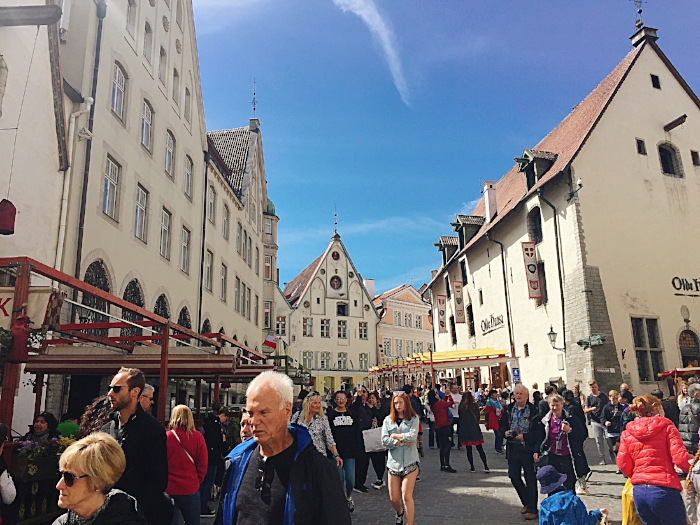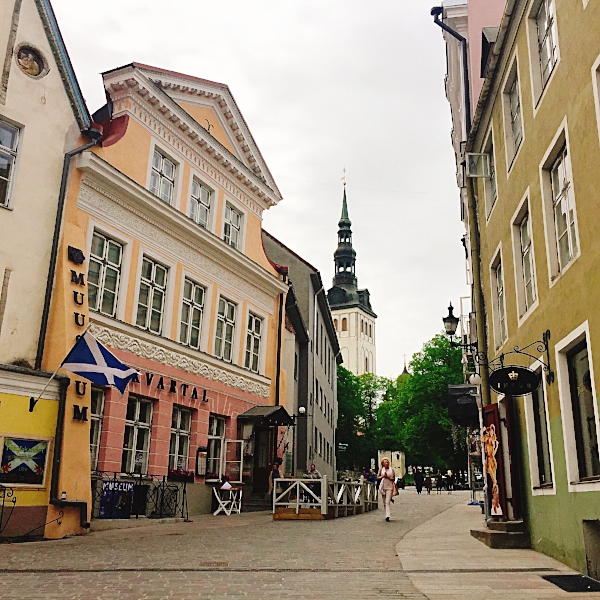Disney Cruise Baltic Sea: Tallinn
Built during the 14th century, the Viru Gate is the first thing that greets visitors into the Old Town. Once there, it is as if time has stood still in. It once had 8 gates and several towers, but with time and modernization, only this gate remains as the main entryway into Tallinn's medieval town.
The Disney Cruise Line across the Baltic Sea began its seven-day sojourn from Copenhagen. After a leisure day at sea on board the Disney Magic, the ship directed its sails to Estonia. Once there, we readied ourselves to explore Tallinn and its Old Town. The Disney Cruise Line bus took its sea-farers to the city. As the bus moved along, we noticed that our surroundings were modern and up-to-date, we had not yet seen a glimpse of its medieval past. When the bus stopped, we scurried our way to a short walk towards the Viru Gate, the main entrance to this wonderfully preserved medieval town.
One can't pay a visit to Tallinn without walking around its Old Town.
The picturesque Town Hall Square, also known as Raekoja plats, has been the undisputed hub of Old Town for the last eight centuries. Lined with colorful merchant houses and packed with cafés, this place is an instant magnet for tourists.
Medieval men and women of their day would probably never imagine the crowds that would flock to this place today.
Lokals say that if you find the round stone marked with a compass rose in the middle of the square and add a bit of stretching, you can see the tops all five of Old Town's spires from this standpoint.
Nothing exudes power like the impressive, Gothic-style Town Hall that dominates medieval Tallinn's main square. The building was built in the years 1402-1404 as a meeting place for the ruling burgomeisters. These days, however, the Town Hall, known as the only intact Gothic town hall in Northern Europe, is used primarily for concerts or for entertaining visiting royals or other dignitaries. A notable building in the square, the Tallinn Town Hall opens its doors to visitors as a museum in July. Its imposing interior boasts of colorful meeting halls, vaulted ceilings, intricate wood carvings and some of the city's most prized art treasures, including that of the famed Tristan and Isolde carved bench.
Just like in the past, the square remains as the social heart of the city, a venue for open-air concerts, handicraft fairs, and medieval markets. The stage is set for just an occasion.
Every winter the Town Hall Square is home to the town's Christmas tree which has been a tradition that dates back to 1441, as well as a buzz-filled Christmas Market. During springtime, it hosts the Old Town Days festival, a modern take on a medieval carnival, where traditions from the Middle Ages are kept alive.
Historically the square has served as a market and meeting place, and according to legend, the site of at least one public execution.
The Town Hall Square has surrounded alleys with shops that display items and other knick-knacks known throughout Estonia.
The Long Boot Street or the Pikk jalg is a steep medieval street along Toompea Hill that takes you to the Alexander Nevsky Cathedral. Here, you can see artists showcasing their works or musicians as you walk your way upward from the Lower Town below.
This building was the former Ungern-Sternberg Palace in Tallinn that has now become the main building of the Estonian Academy of Sciences along Pikk Jalg.
This quirky and unique boot-shaped rainspout can be found in the very street of its name, the Long Boot Street.
St. Alexander Nevsky Cathedral
The onion-domed structure perched atop Toompea Hill is Estonia's main Russian Orthodox cathedral called the St. Alexander Nevsky Cathedral. The cathedral is also by far the grandest, most opulent Orthodox church in Tallinn. The cathedral was dedicated to the Prince of Novgorod, Alexander Yaroslavich Nevsky, who led the famous Battle of the Ice at Lake Peipus which halted the German crusaders' advance from the east. Designed by the acclaimed St. Petersburg architect Mikhail Preobrazhenski, the church is richly decorated in a mixed historicist style. The cathedral's lavish interior is filled with mosaics and icons that is indeed well worth a visit.
Alex, Liza, Amara and I posing for the camera with the St. Alexander Nevsky Cathedral in the background.
Built in 1900, when Estonia was part of the tsarist Russian empire, the cathedral was originally intended as a symbol of the empire's dominance – both religious and political. Its towers hold Tallinn's most powerful church bell ensemble that consists of 11 bells, including the largest in Tallinn, weighing 15 tonnes. One can hear the entire ensemble before each service.
Cathedral of Saint Mary the Virgin (Dome Church)
Established sometime prior to the year 1233 and repeatedly rebuilt since, the Cathedral of Saint Mary the Virgin or the Dome Church, displays different architectural styles. Its vaulted main body dates back to the 14th century, while its Baroque tower is a later addition from the late 1770s. Just inside the main entrance, you'll find a large stone slab which reads, "Otto Johann Thuve, landlord of Edise, Vääna and Koonu Ehis grave, 1696 A.D." Thuve, now sometimes credited as "Tallinn's Don Juan," was a serious drinker and constant womanizer. On his deathbed, he asked to be buried at the threshold of the church so that God-fearing people who knelt down to pray upon entering, might eventually cleanse his soul.
The medieval church that stands at the center of Toompea hill is considered one of the country's most fascinating historical attractions. In addition to seeing the cathedral's fantastic interior, visitors can opt to climb the 69-meter, Baroque bell- tower for incredible views of the city.
One of the most skillful and renowned woodcarvers of the 17th - 18th century, Christian Ackermann, created the pulpit in the year 1686 and the altar during the years 1694-1696.
The beauty of the altar can still be seen through its restorations.
This is the aisle of the church that leads up to the main altar.
The interior is filled with elaborate German funereal coats of arms from the 17th to the 20th centuries as well as burial stones from the 13th to the 18th centuries since this church was primarily used by Estonia's Elite German nobles.
These seasoned almonds that can be found in stalls throughout the Old Town are the bomb! Its a perfect snack to munch on while walking through the town's cobbled steps.
The Danish King's Garden is an open, garden-like place on the slopes of Toompea Hill that happens to be the legendary birthplace of the Danish flag. It was supposedly at this place that King Valdemar II of Denmark and his troops camped before conquering Toompea in 1219. According to legend, Valdemar's forces were losing their battle with the Estonians when suddenly the skies opened, and a red flag with a white cross floated down from the heavens. Taking this as a holy sign, the Danes marched onward to victory.
Look at this naughty little one. Amara really has a knack of posing for the camera.
Liza and Amara beside one of the monks that can be seen inside the Danish King’s Garden. To me, they resemble one of the Death Eaters from Harry Potter with a medieval twist to it.
Don't look up now, there's a faceless monk that greets everyone who steps inside the Danish King's Garden.
The name of the Maiden’s Tower is ironic as this place was once used as a prison for prostitutes. Lokal folklore says that a deal was made in the tower between an ugly prostitute and the devil. The prostitute would give her beauty, and the devil got her soul. As part of the deal, the girl would entice as many male townsfolk to the path of sin as she possibly could. In the end, the prostitute was declared a witch and was executed. Today, the Maiden’s Tower was recently renovated and reopened as a museum, complete with an exhibition hall in its vaulted cellar and café. They say that there is a male voice that can be heard singing when there was no one to be found. The staff of the café has regular reports of ghostly sightings within its vicinity.
The Maiden's Tower is one of the more famous medieval defense towers in Tallinn. Meghede Torne, as it was initially called, was built in 1370-1373 along with the wall that runs through the Danish King’s Garden. You can explore this sturdy, 14th-century tower, sip coffee in its hip café or walk along the Town Wall for some amazing views.
For centuries, the Short Leg Street or otherwise known as Lühike Jalg, the street next to the Danish King’s Garden is known to be the most haunted street in Tallinn. The tower and its connecting gate, the Short Leg Street Tower and accompanying gate as seen here, has kept the lower town of Tallinn separate from the Toompea Hill. At night, the gateway was used to prevent common people from entering the area of the nobility. The gate was also known to not only keep people at bay but also supernatural beings of the underworld to visit the Danish King’s Garden, a favorite dwelling place of the nobility. Watch out for the infamous executed black monk in this narrow street if you dare!
I love walking through streets and passages to find historical and architectural treasures, just like this one. The tower that can be seen at the end of the road is the Niguliste Museum (St. Nicholas' Church). Here, exquisite altarpieces, medieval burial slabs and other works of religious art can be seen in this 1230-era church-turned-museum. Since its restoration in the 1980s, St. Nicholas has functioned as a museum that specializes in works of religious art. The most famous of its collection is the Bernt Notke's beautiful but haunting image of the Danse Macabre (Dance with Death). Moreover, elaborate altarpieces, baroque chandeliers, and centuries-old burial slabs are also on display.
That's it for Tallinn! Can't wait to explore St. Petersburg next! All aboard!



























